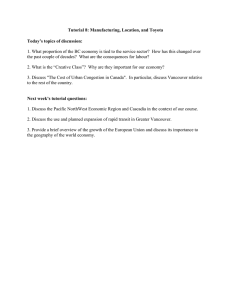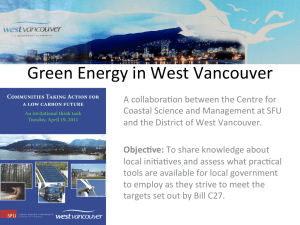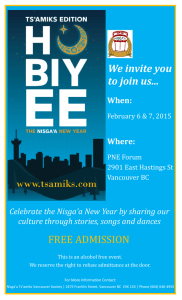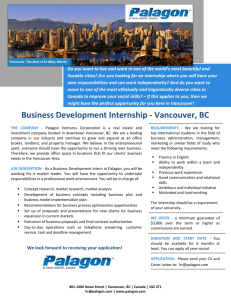A geographical perspective on the role of cities &
advertisement
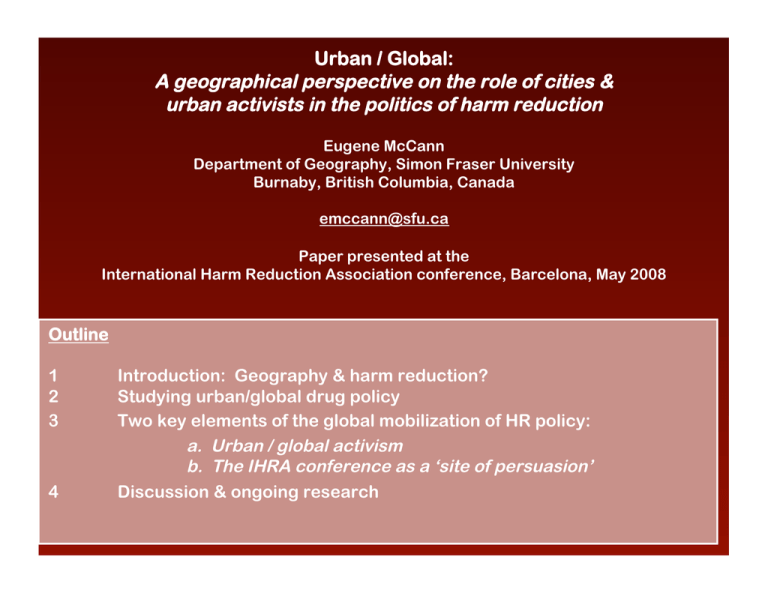
Urban / Global: A geographical perspective on the role of cities & urban activists in the politics of harm reduction Eugene McCann Department of Geography, Simon Fraser University Burnaby, British Columbia, Canada emccann@sfu.ca Paper presented at the International Harm Reduction Association conference, Barcelona, May 2008 Outline 1 2 3 4 Introduction: Geography & harm reduction? Studying urban/global drug policy Two key elements of the global mobilization of HR policy: a. Urban / global activism b. The IHRA conference as a ‘site of persuasion’ Discussion & ongoing research 1 Introduction: Geography & harm reduction? -- 1990s: Epidemic of HIV & Hepatitis C infection among IDUs in Vancouver, Canada. -- Search for solution beyond criminalization model. -- Users and other activists convince the state to institute an HR approach, learned from the 1999 IHRA conference and from models in other Swiss cities, Frankfurt, and elsewhere. -- 2001: Vancouver institutes its ‘4 Pillar’ strategy. -- 2003: ‘Insite,’ N. America’s only legal supervised injection site, opens. -- Numerous studies credit Insite with reducing deaths & infections, encouraging counseling, treatment, & reducing public injection. 1 Introduction: Geography & harm reduction? What’s Geography got to do with it? 1) A basic premise . . . Places are fundamentally social, relational, and scaled. They are produced by social interactions and political struggles that happen both at the local scale and also across other scales (regional, national, global). 2) So geography, or more specifically space, is not a natural container in which human activity occurs. Rather, space is produced by social action and also actively shapes how society operates. (See the work of Henri Lefebvre, David Harvey, Doreen Massey among others.) 1 Introduction: Geography & harm reduction? What’s Geography got to do with it? 3) More specifically . . . Urban policies result from social interactions at various scales. Urban actors engage with their peers around the world to learn and teach about best practices. They ‘mobilize’ policies, transferring them from one place to another, in order to shape the character of places. (Geographers like Jamie Peck and Kevin Ward have recently made this argument.) McCann, E.J. 2008. Expertise, Truth, and Urban Policy Mobilities: Global Circuits of Knowledge in the Development of Vancouver, Canada’s ‘Four Pillar’ Drug Strategy. Environment and Planning A, Vol.40 No.4, pp.885-904. Email emccann@sfu.ca for a copy. 2 Studying urban/global drug policy Geographer Doreen Massey argues that to understand how cities operate, we must have a ‘global sense of place.’ In terms of Harm Reduction policy, cities like Frankfurt, Sydney, and Vancouver are ‘global cities’ – actors working in those places have engaged more widely to teach and learn about innovative drug policies. Urban drug policy activists and professionals have used the global scale strategically and politically as a resource from which to draw best practices for harm reduction and to influence policy-making locally. 2 Studying urban/global drug policy To understand exactly how this urban/global process works, it is necessary to engage in a geography and an ethnography of urban/global policy-making; to follow the actors and models through specific sites of knowledge exchange and political struggle. Why study harm reduction policy from this perspective? It’s intellectually interesting but it also promises to produce general lessons from specific cases. 3a Activists and policy-makers learning from global discussions on Harm Reduction [W]e have a huge injection drug problem, and . . . I heard of European cities who had been through the same, very similar situations. Growth of open drug scenes, growth of open injection, higher overdose drug rates, HIV . . . So in March of ’99 I went to Geneva and Frankfurt to followup . . .. So it was really, “Okay, let’s go look at these, let’s go look at what they’ve done. Let’s go, let’s go look at a safe injection site. What does it look like? How does it work? How do they manage to implement this? What was their story?” Because it’s all very political, this business. And so, what was the Frankfurt story? What was the Zurich story? Those stories became very powerful. --Interview, senior drug policy official, Vancouver 3a Activists and policy-makers learning from global discussions on Harm Reduction [P]eople from Bern, Switzerland, Frankfurt, and . . . Merseyside, Liverpool, [were brought] to an event here. And that was the first time I actually got to talk to other people from the local government level. . . . It was a real watershed in terms of making connections. And so people like me, who were at that point really interested in this issue and had heard of these cities, suddenly got to talk to the chief of police from Frankfurt and make these connections and exchange business cards with people . . . --Interview, senior drug policy official, Vancouver 3a Activists and policy-makers learning from global discussions on Harm Reduction [A policy think-tank in Vancouver] had the most posh conference, so it’s 350 [dollars] to get in. So, I called them up and said, “Could you…” and made us sound like a Sunday School group. …They got us two free tickets at the door. We showed up with eight people and got them all in. It was so amazing. …It was good for the users. It was neat that they were there because we started to attend everything. - Interview, Vancouver Area Network of Drug Users (VANDU) organizer 3b The IHRA conference as a ‘site of persuasion’ We would just cling to [this information] … [I]t’s really empowering for users to understand that drug users elsewhere were being treated as citizens, citizens that are deserving, you know, [with] compassion.” - Interview, Vancouver Area Network of Drug Users (VANDU) organizer 3b The IHRA conference as a ‘site of persuasion’ Carrigg, D. 2004. Mayor heads to Oz for drug talk. Vancouver Courier online edition. March 21st, 2004. 3b The IHRA conference as a ‘site of persuasion’ [O]ne of the reasons [the International Harm Reduction conference] is coming to Vancouver is because of what we’ve accomplished here. . . . There will be some presentations about what’s done in Vancouver, but it’s an international conference, so there will be people from all over the world presenting. Both coming here to see Vancouver but also bringing their own context and presentations. And there will be some focus on cities . . . A city has an identity . . . is it a good city, is it an awful city, is it a caring city? . . . [T]here’s lots of opportunities for cities to carve out their direction in this area. --Interview, senior drug policy official, Vancouver. 4 Discussion & ongoing research Global ‘mobilities’ flow through key sites, nodes, or infrastructures which “involve occasioned, intermittent face-to-face conversations and meetings within certain places at certain moments that seem obligatory for the sustaining of . . . friendship, workgroups, . . and . . . organizations” (Hannam, et al, 2006, pp.14-15). The meeting rooms, hallways, cafes, bars, and restaurants of conferences are “globalizing ‘microspaces’” (Larner and LeHeron, 2002, p.765) where lessons are learned, where trust is developed, and where strategies are formulated among participants. They are ‘sites of persuasion’ that shape geographies of knowledge and policy. And they offer opportunities for empowerment and political action. 4 Discussion & ongoing research The Barcelona IHRA conference is an opportunity for me to learn about these processes of teaching, learning, and empowerment. It is an ‘ethnographic research site.’ If you or or one of your colleagues would like to talk about experiences of this conference or previous ones, I’d be happy to listen either at the conference or afterwards. emccann@sfu.ca
